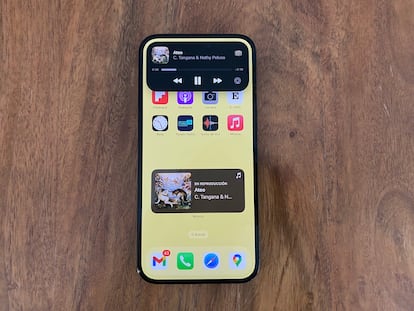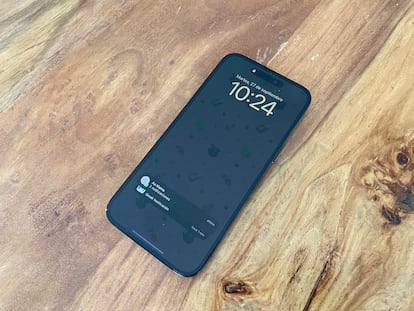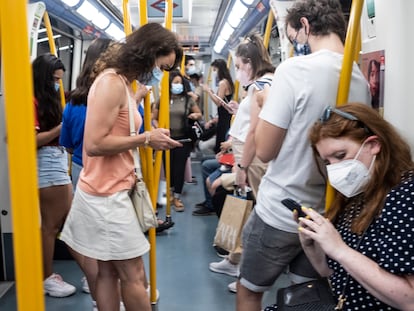iPhone 14 Pro Max: The pros and cons of Apple’s most expensive cellphone
EL PAÍS tested the new smartphone, which includes a 48-megapixel camera, a new screen feature called Dynamic Island and action-mode video recording

The iPhone 14 Pro Max is Apple’s most ambitious project. It makes the leap to 48 megapixels for the first time, includes an improved screen and stands out for its high-end performance. But the main drawback of this gigantic mobile device is its price, which can be prohibitive for some users: the most expensive iPhone in history starts at $1,400. Its predecessor topped out at $1,250.
EL PAÍS tested out the iPhone 14 Pro Max for a few days. The design is still bulky and heavy, like the previous model: 6.3 inches tall, 3.1 wide and 0.3 thick. It weighs 240 grams – almost the same as the iPhone 13 Pro Max’s 238 grams. While the rear camera module is slightly larger, the most notable change is the so-called “Dynamic Island,” which appears when an iPhone is unlocked. This feature surrounds the phone’s front camera and FaceID, doubling as a hub for alerts, notifications, app shortcuts and music. Now, for instance, when you play an Apple Music song, a thumbnail of the album art appears, along with a waveform animation. The Dynamic Island also opens a larger window at the top of the screen, showing the song title, band and playback controls. Incoming calls, timers and apps such as WhatsApp can also be accessed via the Dynamic Island, which saves time you time from switching between other applications. However, the feature can be a bit intrusive when you are trying to play games or watch full-screen videos.
The other novelty of the iPhone 14 Pro Max screen – which measures 6.7 inches – is that it can always stay on. The user can see the lock screen – albeit at a much lower brightness level – at all times. It’s easy to see the time and check notifications without having to constantly unlock the phone… but this obviously consumes more battery power. On the bright side, the screen turns off automatically when you put the iPhone face down on a table or in your pocket. The user can also choose to totally disable this option.
The iPhone 14 aspires to become the king of photography. It includes a front camera, a telephoto lens and ultra-wide angles. For years, Apple had been investing in 12-megapixel sensors, but the new model has a 48-megapixel main sensor that, in theory, can capture four times more light. It takes incredible photos that are realistic and sharp, both during the day and at night. In the dark, however, the photographs sometimes look a bit artificial.

Video-recording is another of the phone’s strengths. With the iPhone 13, cinema mode arrived, offering automatic focus changes and enabling users to record people, pets and objects with a depth effect. The iPhone 14 Pro and 14 Pro Max have now launched the action mode, designed to capture clear, high-quality videos with just one hand – even when the person recording is moving around.
The phone debuts a new processor – the A16 Bionic – and offers four potential storage options: 128 GB, 256 GB, 512 GB and 1TB. EL PAÍS tested the 1TB version. The performance is high when playing games, browsing the internet or making recordings. The apps run without any delays.
The iPhone 14 has good endurance, especially if the always-on screen mode is deactivated. The battery usually lasts the full day, even if the cellphone is actively used. However, Apple still has quite a bit of room for improvement when it comes to fast charging. While some cellphones charge their battery in just 20 minutes, in the tests carried out by this newspaper, it took just over an hour-and-a-half to fully charge the iPhone 14.

Since 2020, Apple has not included a charger with its phones, citing “environmental reasons.” But the company also rejects what some experts would consider to be the most environmentally-friendly measure: creating a universal charger for all device models. On the Apple website, the price of a charger starts at $25.
Tu suscripción se está usando en otro dispositivo
¿Quieres añadir otro usuario a tu suscripción?
Si continúas leyendo en este dispositivo, no se podrá leer en el otro.
FlechaTu suscripción se está usando en otro dispositivo y solo puedes acceder a EL PAÍS desde un dispositivo a la vez.
Si quieres compartir tu cuenta, cambia tu suscripción a la modalidad Premium, así podrás añadir otro usuario. Cada uno accederá con su propia cuenta de email, lo que os permitirá personalizar vuestra experiencia en EL PAÍS.
¿Tienes una suscripción de empresa? Accede aquí para contratar más cuentas.
En el caso de no saber quién está usando tu cuenta, te recomendamos cambiar tu contraseña aquí.
Si decides continuar compartiendo tu cuenta, este mensaje se mostrará en tu dispositivo y en el de la otra persona que está usando tu cuenta de forma indefinida, afectando a tu experiencia de lectura. Puedes consultar aquí los términos y condiciones de la suscripción digital.
More information
Últimas noticias
Half of Scotland is in the hands of 420 property owners
Pinochet’s victims grapple with José Antonio Kast’s rise in Chile
Reinhard Genzel, Nobel laureate in physics: ‘One-minute videos will never give you the truth’
From digital curfews to blocking apps: How technology experts protect their children online
Most viewed
- Pablo Escobar’s hippos: A serious environmental problem, 40 years on
- Reinhard Genzel, Nobel laureate in physics: ‘One-minute videos will never give you the truth’
- Why we lost the habit of sleeping in two segments and how that changed our sense of time
- Charles Dubouloz, mountaineering star, retires at 36 with a farewell tour inspired by Walter Bonatti
- The Florida Keys tourist paradise is besieged by immigration agents: ‘We’ve never seen anything like this’











































